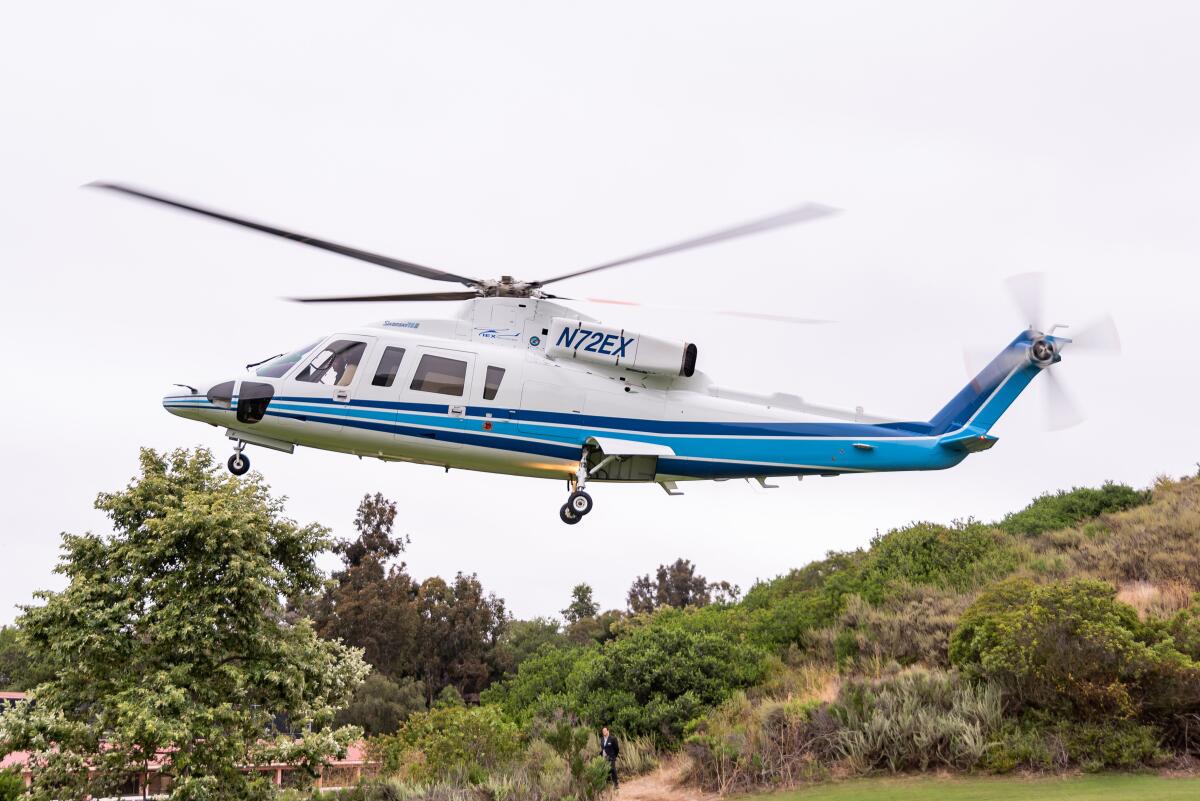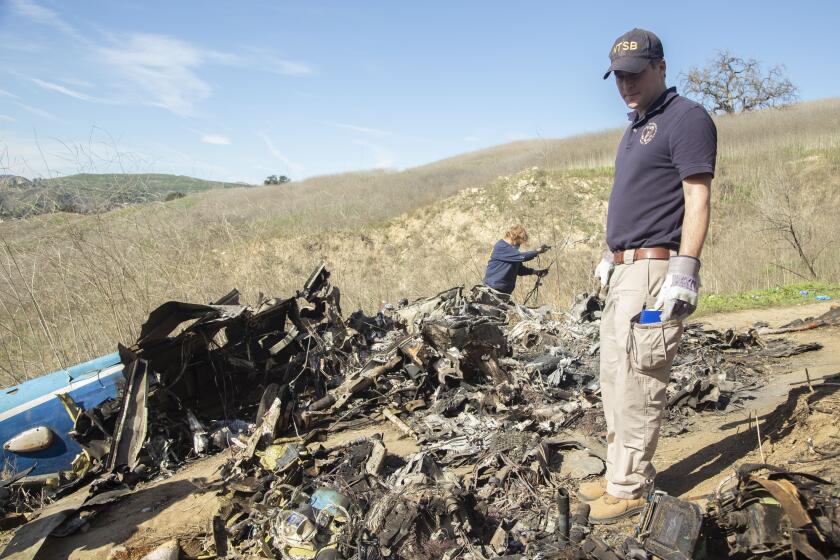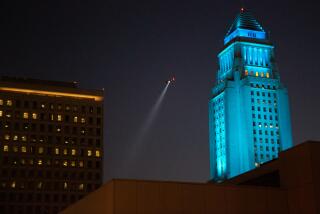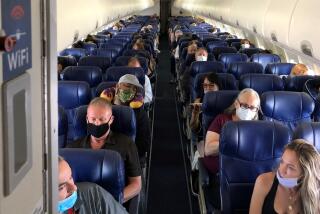Despite pleas from Vanessa Bryant, investigators, safety rules inspired by Kobe Bryant helicopter crash stall

- Share via
The helicopter crash that killed NBA legend Kobe Bryant, his daughter Gianna and seven other people on a foggy morning a year ago on a hillside in Calabasas placed a new and urgent focus on what many had long considered significant flaws in federal aviation regulation.
Such large turbine helicopters are not required to have a terrain awareness warning system, known as TAWS, to alert a pilot if they are about to fly into rising topography. Nor must they have flight data or cockpit voice recorders.
There were immediate calls to close the loopholes and require those systems. Bryant’s wife, Vanessa, advocated for the changes. In its immediate comment after the crash, the National Transportation Safety Board said a terrain warning system on the helicopter could have helped the pilot.
But as the public focus shifted away, the reform effort stalled. Opposition from the aviation industry, combined with a Congress overwhelmed with the COVID-19 pandemic and other issues, pushed helicopter safety to the back burner.
“Even the death of Kobe Bryant hasn’t gotten us where we need to go,” Rep. Brad Sherman (D-Northridge) said.
Sherman introduced the Kobe and Gianna Bryant Helicopter Safety Act, which would mandate terrain awareness systems for all turbine helicopters capable of carrying six or more passengers and also require they have crash-proof black boxes.
“Aviation firms oppose this because they say these systems aren’t cheap,” he said.
The aviation industry argued that the systems are not always necessary for pilots and balked at the costs of installation and repair — upward of $35,000 per helicopter, plus hours of maintenance costs and time lost with repairs and installation.
But there is a growing body of evidence that TAWS has become increasingly effective over time and can save lives. The system in helicopters can help prevent crashes, especially when a pilot has limited visibility, by providing details of the surrounding terrain and visual and audio warnings of obstacles or mountainous topography.
Bryant and his daughter, along with several of her teammates, a few parents and coaches, took off shortly after 9 a.m. on Jan. 26 from John Wayne Airport in Orange County, heading to Camarillo Airport for the second day of a weekend tournament at the Mamba Academy in nearby Thousand Oaks. Pilot Ara Zobayan sought air traffic control guidance as a low cloud ceiling hung over the San Fernando Valley into Calabasas.
A collection of texts, radio communications, quotes and scenes from the last hours of Kobe Bryant’s life before the fatal helicopter crash in Calabasas.
Zobayan told air traffic control he was “climbing” to 4,000 feet to get above the clouds. But in reality, he was descending, having no warning of the rising terrain ahead of him. The helicopter crashed into the hillside near Las Virgenes Road and Willow Glen Street at 9:45 a.m., killing all aboard.
Records show that the Bryant crash had familiar echoes to a tragedy 16 years earlier.
On March 23, 2004, an almost identical Sikorsky S-76 helicopter crashed into the Gulf of Mexico 70 miles southeast of Galveston, Texas, on a night trip to an oil drilling ship, killing all 10 onboard.
Two years later, the NTSB found that while flying at night, the pilots failed to realize they were descending.
It cited “the crew’s failure to identify and arrest the aircraft’s descent for undetermined reasons which resulted in controlled flight into the water.”
The NTSB concluded that a terrain awareness warning system could have alerted the pilots to the waters below and avoided the fatal plunge. The device would have been triggered 55 seconds before impact and could have “saved the lives of all those aboard.”
The board sent a recommendation to the Federal Aviation Administration to mandate them on all helicopters carrying six passengers or more.
The FAA rejected the recommendation, and such warning systems are still voluntary to this day on all but medical helicopters.
A recommendation for those helicopters that same year for black boxes that track every move and record the pilot’s voice has also been rejected.
Terrain awareness technology, developed in the 1970s and first deployed on big commercial jets, finally made it to smaller planes with six or more passengers with a decision by the FAA in 2000. At the time, a version of the warning system for helicopters was still in its early stages.
But by 2005, Sikorsky had voluntarily begun installing the system in its new versions of the S-76 helicopter. It also offered retrofits on older helicopters like the 1991 Sikorsky S-76B that carried Kobe and Gianna Bryant, Christina Mauser; Payton and Sarah Chester; John, Keri and Alyssa Altobelli; and Zobayan, the pilot.
Still, the helicopter industry, in comments to the FAA, questioned the level of success for rotorcraft often hugging the terrain.
During a special investigation by the NTSB that examined medical flight crashes from 2002 to 2005, the board documented 55 prior helicopter and aircraft crashes resulting in 54 fatalities and 18 serious injuries. It determined that 17 could have been prevented with TAWS, amping up pressure on the FAA.
In 2014, the FAA made TAWS mandatory for helicopter air ambulances, but the system remains voluntary in larger commercial helicopters. The FAA examined 62 accidents involving helicopter air ambulances from 1991 to 2010 and determined TAWS and a series of other safety reforms could have saved 125 lives.
Nationwide at the time, there were 1,515 medical helicopters, according to FAA. The NTSB called the decision not to extend the requirement to turbine commercial helicopters “unacceptable.”
After examining the mangled wreckage of the Calabasas crash, NTSB board member Jennifer Homendy said, “Certainly, TAWS could have helped to provide information to the pilot on what terrain the pilot was flying in.”
She cautioned that it was too early to say whether it would have prevented the tragedy, but did note that the FAA “failed to act” on the NTSB’s recommendation to mandate TAWS.
Bob Clifford, a leading aviation disaster litigator, said that while the NTSB considers only how to make those on a helicopter safer, the FAA must weigh economic costs to helicopter operators. Those operators are attached to powerful groups, including the oil and gas industry, which needs millions of workers transported annually, he said.
In the wake of the Bryant crash, the FAA sought to explain why it chose to extend the TAWS requirement only to helicopter air ambulances. It noted in a statement that those helicopters fly at “night and from unimproved and unfamiliar landing areas” that the agency said is far from the scenario with commercial helicopters that tend to fly “in populated areas, relying on a robust network of routes and landing facilities.”
The agency said safety improvements unrelated to new rules, like increased automation, have contributed to the U.S. helicopter fatality rate dropping by half over the last two decades.
“The FAA promotes voluntary equipage of flight recorders in aircraft for which regulations do not require these devices,” the FAA said in a statement.
But Sen. Dianne Feinstein (D-Calif.), in introducing legislation last year, painted a different picture.
“We saw the deadly results of this inaction in January when a helicopter carrying Kobe Bryant, his daughter and seven others crashed. If that helicopter had terrain awareness equipment, the tragedy may have been averted,” she said.
Feinstein will reintroduce introduce the bill this week, sources say.
Helicopter Assn. International President James Viola said that although his group supports safety improvements, “mandating a ‘one solution fits all’ approach can actually lead to safety concerns in some operations.”
In a statement to The Times, Viola said more than half of helicopter crashes result from human factors such as loss of control in flight and flying into bad weather.
“Mandating the use of specific equipment to the entire industry mission profile is ineffective, potentially hazardous, and prevents the industry from being able to realize the benefits of a holistic approach to safety,” he said.
NTSB to hold Feb. 9 hearing to determine cause of helicopter crash that killed Kobe Bryant, 8 others
The NTSB has ruled out engine and mechanical failure on the Sikorsky S-76B helicopter. It has yet to provide a probable cause for the Jan. 26, 2020 crash.
He warned that “prescriptive legislation and regulations” take away from the industry the ability to seek out better approaches “and may close the door to the development and implementation of future innovative safety technologies.”
Vanessa Bryant strongly urged Congress to act, saying “aircraft companies must do their part to protect lives.”
“I believe there is a chance that Kobe and Gianna would still be alive today if their helicopter had been equipped with the safety equipment required by pending federal legislation,” she said in a statement.
She has sued the helicopter operator, accusing it of negligence for not having a terrain awareness system onboard.
NTSB investigators have cautioned that because of the helicopter’s speed — an estimated 140 knots plus — a terrain awareness system may not have saved those on the Bryant helicopter.
A Times investigation last year found that even before the crash, as the helicopter followed the 101 Freeway at Mureau Road in Calabasas, it cleared the hillside with 100 feet or less to spare. Such a distance would have triggered TAWS alerts.
Kurt Deetz, a pilot who used to work alongside Zobayan, has said that TAWS could be a distraction to the pilot with its squawking “terrain, terrain” warnings and pilots will sometimes turn it off when flying around tall buildings. Pilots can also set the boundaries in a way that makes the system less effective.
Critics point out that TAWS-equipped helicopters have also crashed. In March 2016, four people died in an air ambulance near Enterprise, Ala., despite being equipped with TAWS. The crew had just picked up a patient from a car crash in heavy fog and misty conditions when it crashed. The NTSB found the pilot was flying visually at night in bad weather and suffered spatial disorientation.
Zobayan may have had the same problem. While the NTSB is not due to make a finding of the probable cause until Feb. 9, it has noted in investigative documents that the pilot “could have misperceived both pitch and roll angles.”
“When a pilot misperceives altitude and acceleration, it is known as the ‘somatogravic illusion’ and can cause spatial disorientation,” the report said.
As a new Congress convenes, Sherman said, “We’re going to take another run at this.”
More to Read
Sign up for Essential California
The most important California stories and recommendations in your inbox every morning.
You may occasionally receive promotional content from the Los Angeles Times.













